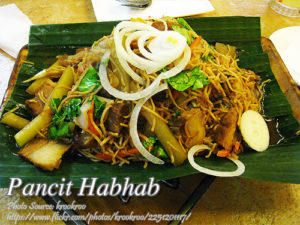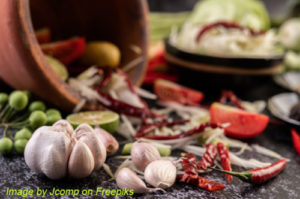This pancit bihon guisado version is very easy and the ingredients are simple and easy to find and prepare. Actually cooking pancit bihon need not be loaded with lots of ingredients to make it tasty. The truth is, if the bihon noodles are tasty enough, no amount of garnishing or other complex ingredients can make it taste better. You will be surprised this pancit contains simple ingredients such as cabbage, carrots, green beans, squidballs, pork, and Chinese chorizo or longganisang Macau. No need for expensive shrimps or prawns or Chinese mushrooms to make it tasty.
Pancit Bihon Guisado: A Simple Yet Flavorful Filipino Classic
When I think of pancit bihon guisado, I’m instantly transported back to my childhood in Cavite. My Tita Rosa, who had a reputation for making the best pancit during family gatherings, would always say, “Hindi kailangan magastos para maging masarap ang pancit.” True enough, her pancit was simple, budget-friendly, and brimming with flavor. It was never about how many toppings she added—it was all about the taste of the noodles and the care she poured into the cooking.
If you’re looking to recreate this classic Filipino dish, don’t be intimidated! This recipe is beginner-friendly, uses everyday ingredients, and doesn’t rely on fancy extras like prawns or mushrooms. Let me guide you through this recipe as though we’re chatting in a warm Filipino kitchen.
The Story Behind Pancit Bihon
Pancit, derived from the Hokkien word pian e sit meaning “something conveniently cooked,” reflects the influence of Chinese immigrants in the Philippines. Pancit bihon is one of the most popular varieties, made with thin rice noodles sautéed with meat, seafood, and vegetables. Over time, Filipinos have given this dish its own identity, adapting it to local ingredients and flavors.
This recipe stays true to that philosophy of simplicity. My Uncle Boyet from Pampanga insists on using basic ingredients like cabbage, carrots, and pork, because he says, “Mas ramdam mo ang lasa ng bihon kapag hindi masyadong maraming sangkap.” That simplicity is where its charm lies.
Preparing the Bihon Noodles
The first step to perfect pancit bihon is properly preparing the noodles. My cousin Lita taught me this trick when she made pancit for her town fiesta. She always soaked the noodles in water for about 10 minutes before cooking. This step softens the bihon and ensures it cooks evenly later. If you skip this step, you might end up with noodles that are either too tough or too mushy.
Building Flavor with Meat and Seafood
One thing I love about this recipe is how it combines the savory goodness of pork and the unique taste of squid balls. Using longganisang Macau—or if you prefer, Chinese chorizo—adds a hint of sweetness and smokiness that balances the dish. Tita Rosa always fried the squid balls and chorizo first, removing them before sautéing the garlic and onions. She explained that this step allows the oil to absorb those rich flavors, which then infuse the rest of the dish.
When you’re sautéing the pork, remember to season it well with salt and pepper. My mom always said, “Magpalasa ka na sa karne pa lang,” meaning the meat should already be flavorful on its own before combining it with the other ingredients.
A Perfect Blend of Vegetables
For the vegetables, this recipe keeps things simple with cabbage, carrots, and green beans, also known as Baguio beans. These are staples in most Filipino kitchens, making this dish both economical and accessible. The secret is to cook the vegetables just until they’re tender-crisp, so they retain their vibrant color and slight crunch.
When adding the shrimp cube, my Lola Puring had a tip that I still follow to this day: dissolve it in the cooking liquid before mixing it with the noodles. This ensures that the flavor is distributed evenly throughout the pancit.
Tossing It All Together
The last and most satisfying part is tossing everything together. This is where you’ll need a bit of technique. My dad used to use two large spatulas to toss the bihon noodles, vegetables, and meats together in the wok. He always said this was the step where you “marry the flavors.” By the end, the noodles absorb all the savory, umami-packed sauce, becoming tender and flavorful.
This step might seem daunting, but don’t worry. As long as you keep the noodles moving, they’ll absorb just the right amount of liquid without turning soggy. If the wok feels too crowded, you can toss the ingredients in batches to make sure everything is evenly coated.
Serving Pancit Bihon with a Filipino Twist
No pancit bihon is complete without a squeeze of calamansi juice. This tiny citrus fruit adds a burst of tanginess that brightens up the entire dish. My kuya would always joke that pancit isn’t “pancit” without calamansi on the side. A sprinkle of fried garlic as garnish also adds a nice crunch and a nutty aroma.
Serve it on a large platter, and you’ll see how quickly it disappears. In Filipino culture, pancit is often associated with celebrations, symbolizing long life and prosperity. But even on ordinary days, it’s a dish that brings comfort and joy to every family table.
Food for Thought: The Universality of Pancit
Pancit bihon may have Chinese roots, but it has become an integral part of Filipino identity. What makes it special is its adaptability—you can tailor it to whatever ingredients you have on hand. Some households prefer shrimp, others add chicken or tofu. No matter how it’s made, it always carries the essence of togetherness and the joy of sharing food with loved ones.
So the next time you’re craving something hearty, flavorful, and nostalgic, why not give this pancit bihon recipe a try? As Tita Rosa always said, “Ang tunay na sarap ng pancit, galing sa pagmamahal ng nagluluto.” The true taste of pancit comes from the love of the one who cooks it.
Pancit Bihon Guisado (Easy to Cook Version)
Ingredients
- 500 grams bihon noodles dried
- 250 grams pork liempo sliced
- 1/4 head cabbage chopped
- 1 pc carrot slice into strips
- 200 grams Baguio beans sliced diagonally
- 1/4 cup oyster sauce
- 3 Tbsp. soy sauce
- 5 cloves garlic minced
- 1 medium sized onion minced
- 2 pcs longganisang macau Chinese chorizo,sliced diagonally 1/8 inch thick
- 1 cup squid balls quartered
- 1 pc shrimp boullion cube
- 2 to 3 cups water
- 1/2 tsp salt
- 1/4 tsp pepper
- cooking oil for sauteing
Instructions
How to Cook Pancit Bihon Guisado:
- Soak the bihon noodles in water for 10 minutes. Drain.
- In a hot wok, put 3 tablespoon cooking oil and saute the squid balls until slightly brown, remove from wok and set aside.
- In the same wok, saute the longganisang macau until brown, remove from wok and set aside.
- Heat same wok again and add more oil then saute garlic and onion until onions are soft.
- Add in the pork and season with salt and pepper. Saute the pork for a minute then cover.
- Simmer for 5 minutes while sauteing from time to time. Stir until the fat is rendered.
- Then pour the oyster sauce and stir. Next add in the soy sauce and continue stirring. Season with ground pepper.
- Add in the shrimp cube, carrots, Baguio beans and cabbage. Stir again for a minute then pour the water.
- Bring to a boil and simmer the vegetables until half cooked.
- Then add the squid balls, longganisang macau and soaked bihon noodles. Then toss the ingredients using two spatulas.
- Toss until the bihon noodles absorbed the liquid and the pancit is almost dry.
- Transfer to a serving dish and serve with sliced calamansi. Garnish with fried garlic if desired.
Video
Watch the Video on How to Cook Pancit Bihon Guisado the Easy Way:
Notes
Cooking Tips:
Properly Soak the Bihon Noodles
Soaking the bihon noodles in water for about 10 minutes softens them, ensuring they cook evenly. Avoid soaking them for too long as they may become overly soft and break apart during cooking. Drain them thoroughly before adding them to the wok to prevent excess water from diluting the flavors.Sauté Ingredients in Layers for Richer Flavor
Cook each ingredient—squid balls, longganisang Macau, and pork—individually to build layers of flavor. This technique allows the oil to absorb the taste of each component, which enhances the overall dish when combined. Remember to deglaze the pan with your sauces to incorporate all those flavorful browned bits.Toss the Noodles Carefully
When tossing the bihon noodles with the other ingredients, use two spatulas to ensure even mixing without breaking the noodles. Tossing also helps the noodles absorb the sauce and prevents clumping. Work quickly but gently, allowing the flavors to meld while keeping the noodles intact.





